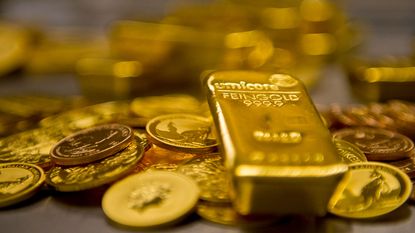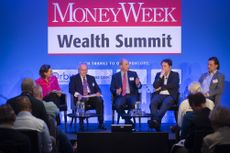Why gold has been such a bad investment so far this year
Gold – the ultimate safe haven investment – is proving anything but safe. It’s lost over $200 an ounce since its high at the start of the year. Dominic Frisby looks at what’s gone wrong.


Poor old gold – beaten up, mocked, ignored and loathed. And yet it’s still there. It always will be there.
You can beat it up as much as you like. You can beat it into a layer of film barely an atom thick. But there is one thing you can’t do to this most malleable of metals and that is destroy it. It is permanent.
And yet gold’s performance in 2021 has been anything but golden.
Subscribe to MoneyWeek
Subscribe to MoneyWeek today and get your first six magazine issues absolutely FREE

Sign up to Money Morning
Don't miss the latest investment and personal finances news, market analysis, plus money-saving tips with our free twice-daily newsletter
Don't miss the latest investment and personal finances news, market analysis, plus money-saving tips with our free twice-daily newsletter
Gold is an analogue asset in a digital world
Gold began the year at around $1,950 an ounce. Here we are, barely two months in, and nearly $250 lower. This is a bear market of the old-school grinding variety. The safe haven is anything but safe. Gold has been so bad even the pound is outperforming it. So has the euro, the US dollar, heck, even the Turkish lira.
Do you know what gold’s biggest problem is? It isn’t rising bond yields – yes, that has driven the price of gold lower these past couple of months – but in the longer term, the issue is digital technology. Future historians may come to describe the era we are going through as the Digital Revolution. In the last 30 years, the growth of the digital economy has eclipsed pretty much anything the physical economy has had to offer.
The internet, computers, smartphones, social media, video, music, photography, e-publishing, e-commerce, e-finance. Even money itself has gone digital – only around 2%-3% of the money in the world actually exists in physical cash form. Digital debt has even pushed up the value of real estate and other financial assets.
Today’s value is in digital assets – trademarks, intellectual property, data, shares in tech stocks, bitcoin. The analogue economy has seen growth, but nothing like the growth of digital. Mines, farms, old school retail are dogs compared to the unicorns of Silicon Valley and Seattle. And gold is the most analogue, physical asset of the lot.
Why do we even need it, now we have “gold 2.0” – digital gold in the form of bitcoin, I wonder? The market seems to agree. While gold has seen $12bn of outflow, bitcoin has seen $6bn of inflow. Bitcoin’s technology is better; its marketing is better; countless millionaires and billionaires are parading their rapidly-found wealth, discovered thanks to this new religion. An endless supply of memes.
An army of coders, investors, communicators and more, perfectly adapted to this new digital world, all acting voluntarily, like the armies of the early Roman Republic, united by the shared goal of the untold wealth that bitcoin at $100,000 or $1,000,000 will bring. Its network effect is like nothing else.
Gold is losing the narrative game
Goldbugs, meanwhile, don’t even know what a meme is. The World Gold Council, plump, stolid and bereft of imagination, stares at this new movement in baffled incomprehension, then goes off for an expensive lunch, paid for by a business model that benefits it, but no one else. It does not stop to ask itself why Elon Musk is tweeting about dogecoin, yet not about gold.
Gold is the most alluring substance on earth, yet it has been incapable of making itself alluring. In the bull market of the 2000s, gold saw innovation. There was the invention of the gold exchange traded fund (ETF) which brought billions of institutional money into the metal. There were the likes of Goldmoney, Bullionvault and Goldcore, which brought gold to retail investors.
There has been innovation today: the Glint gold credit card; Mené’s 24-carat gold jewellery; the Totenpass digital storage pass; a plethora of gold-backed crypto-coins that nobody cares about. But it has been an uphill battle for all of them; there is no coordinated network.
I spoke to my old buddy, analyst Ross Norman, last night. For many years he was the top forecaster for the London Bullion Market Association (LBMA). “Neither central banks nor the institutional investor have been buying,” he says. “In fact, the latter has been baling. So two key drivers of the market last year have gone.” There are some positives, however. “Gold is trading at a premium in China. That physical demand will support the market.”
Norman continues: “We have rising bond yields indicating inflation is there, but when we start to see real data that ‘proves’ it, that will help gold. I’ve always said this year would be a game of two halves. Weakness in the first part of the year, but in the second half, as we see evidence of inflation coming through, gold will be stronger. So I’m comfortable in my prediction of an average price of just $2,000 for the year with highs around $2,300.” That would be some turnaround from here. He agrees. A weaker dollar will help.
Trends don’t go on forever, but they can go on or a lot longer that people expect. A perfect trend sees the price above the short-term moving average, then the medium term, then the long term. Technical analysts call this golden alignment – all are sloping up. Gold has this but in opposite. The price is below the short-term moving average, which is below the medium term, which is beneath the long term. It’s as bad as it gets.
I still own gold - I always will. I own gold miners; I’m a gold bug. A bounce here from oversold levels is likely, but the trend is down. Unless gold can adapt itself to the realities of the digital economy, and thereby make itself alluring again, it will continue to lose relevance. That it was once used as money is no longer enough. We remain below the highs of 2011.
Daylight Robbery – How Tax Shaped The Past And Will Change The Future is now out in paperback at Amazon and all good bookstores with the audiobook, read by Dominic, on Audible and elsewhere.
Dominic Frisby (“mercurially witty” – the Spectator) is the world’s only financial writer and comedian. He is MoneyWeek’s main commentator on gold, commodities, currencies and cryptocurrencies. He is the author of the books Bitcoin: the Future of Money? and Life After The State. He also co-wrote the documentary Four Horsemen, and presents the chat show, Stuff That Interests Me.
His show 2016 Let’s Talk About Tax was a huge hit at the Edinburgh Festival and Penguin Random House have since commissioned him to write a book on the subject – Daylight Robbery – the past, present and future of tax will be published later this year. His 2018 Edinburgh Festival show, Dominic Frisby's Financial Gameshow, won rave reviews. Dominic was educated at St Paul's School, Manchester University and the Webber-Douglas Academy Of Dramatic Art.
You can follow him on Twitter @dominicfrisby
-
 IHT receipts hit record high – is it set to rise further?
IHT receipts hit record high – is it set to rise further?HMRC is set to collect a historic number of IHT receipts between April 2023 and March 2024. We look at how you can stop the taxman eating into your inheritance.
By Vaishali Varu Published
-
 Adidas, Nike or Jordans - could collectable trainers make you rich?
Adidas, Nike or Jordans - could collectable trainers make you rich?The right pair of trainers can fetch six figures. Here's how you can start collecting vintage Adidas, Nike or Jordans now
By Chris Carter Published
-
 Halifax: House price slump continues as prices slide for the sixth consecutive month
Halifax: House price slump continues as prices slide for the sixth consecutive monthUK house prices fell again in September as buyers returned, but the slowdown was not as fast as anticipated, latest Halifax data shows. Where are house prices falling the most?
By Kalpana Fitzpatrick Published
-
 Rents hit a record high - but is the opportunity for buy-to-let investors still strong?
Rents hit a record high - but is the opportunity for buy-to-let investors still strong?UK rent prices have hit a record high with the average hitting over £1,200 a month says Rightmove. Are there still opportunities in buy-to-let?
By Marc Shoffman Published
-
 Pension savers turn to gold investments
Pension savers turn to gold investmentsInvestors are racing to buy gold to protect their pensions from a stock market correction and high inflation, experts say
By Ruth Emery Published
-
 Where to find the best returns from student accommodation
Where to find the best returns from student accommodationStudent accommodation can be a lucrative investment if you know where to look.
By Marc Shoffman Published
-
 Best investing apps
Best investing appsWe round up the best investing apps. Looking for an easy-to-use app to help you start investing, keep track of your portfolio or make trades on the go?
By Ruth Emery Last updated
-
 The world’s best bargain stocks
The world’s best bargain stocksSearching for bargain stocks with Alec Cutler of the Orbis Global Balanced Fund, who tells Andrew Van Sickle which sectors are being overlooked.
By Andrew Van Sickle Published
-
 Revealed: the cheapest cities to own a home in Britain
Revealed: the cheapest cities to own a home in BritainNew research reveals the cheapest cities to own a home, taking account of mortgage payments, utility bills and council tax
By Ruth Emery Published
-
 UK recession: How to protect your portfolio
UK recession: How to protect your portfolioAs the UK recession is confirmed, we look at ways to protect your wealth.
By Henry Sandercock Last updated